|
gm. Dragacz, pow. ¶wiecki, woj. kujawsko-pomorskie

The parish mentioned in 1398. In the second half of the 16th century it is listed as a royal village in the Nowe poviat. In 1591 the Dutch are settled in the village, obtaining a contract for 50 years. The village possesses 32 włókas, 18 morgas, 130 pręts. At the beginning of the 17th century the Kopaniny, Kobelnice and Szałozwiesza pastures were attached to the village. Peasants were exempted from all works, they were only obliged to take care and maintain the bridge on a ferry bordering on Bzowo. In 1598 they were granted a separate privilege allowing them to float grain down the Vistula to Gdańsk, together with Dragacz, Mały Lubień and Mały Wałcz. The contract of 1692 for 50 years from King Jan III authorised peasants to brew beers for their own needs and use other villages' mills. They were also exempted from forced labour. In 1641 the village obtained the contract for 50 yers from King Władysław IV, owed 32 włókas, 18 morgas, 130 pręts and one hakbuda. In 1739 the village owns 28 włókas.
During the Prussian partition the village entered into the ¦wiecie poviat, the Kwidzyn District, belonging to the Górna Grupa Evangelic parish. A linear village, the so-called riverfront village (rzędówka bagienna), situated in the north-western part of the ¦wiecie poviat. The main road runs along the north-south line.
Historic monuments: brick church dating from circa 1680 and five wooden homesteads related to Olęder colonisation dating from the 19th century.
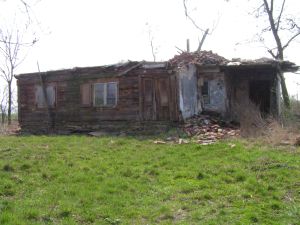 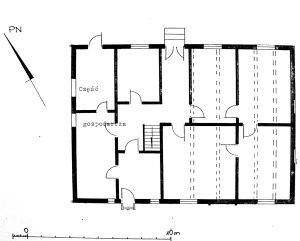 No. 45 - house built in 1833, with its ridge facing a road leading to the embankment; located in the north-eastern part of the village, not connected with farm buildings. The homestead has a dispersed layout. Originally in the lintel there was an inscription "Johann Dobrau B. D Jacob Rathler B. M. 1833".
No. 45 - house built in 1833, with its ridge facing a road leading to the embankment; located in the north-eastern part of the village, not connected with farm buildings. The homestead has a dispersed layout. Originally in the lintel there was an inscription "Johann Dobrau B. D Jacob Rathler B. M. 1833".
Building in ruins. Originally on the plan of a rectangle, double-bay with a hallway in the eastern bay. Kitchen in the western part. Entrance doors in the northern and southern elevations. Lack of roof and of the part of the northern elevation. Originally in form of a cuboid, single-floor, with a cellar under part of it. The northern and southern elevations are bi-axial unsymmetrical. The eastern elevation is single-axial, unsymmetrical. The western elevation is bi-axial, symmetrical.
The house rests on a brick and stone plinth, is made of wood and has a corner-notched structure. No roof truss; originally it had a collar beam roof truss. Originally the roof was thatched. Wooden double-cased windows in window-frames. Wooden, single- and double-leaf doors having a frame and panel structure.
Documents on which the study was based: Zabytki architektury województwa bydgoskiego, eds. M. E. G±siorowscy, Bydgoszcz 1974, p. 225; Katalog zabytków sztuki w Polsce, vol. XI, Dawne województwo bydgoskie, eds. vol. Chrzanowski, M. Kornecki, z. 15: Powiat ¶wiecki, elaborated by vol. Chrzanowski i vol. Żurkowska, Warszawa 1977, p. 9; Wielki Lubień 45, Historic Monuments of Architecture and Construction Registry Card, elaborated by I. Jastrzębska-Puzowska, E. Sekuła-Tauer, K. Bartowski, typescript, Bydgoszcz 1993; Osadnictwo holenderskie Doliny Wisły w województwie bydgoskim, typescript, Bydgoszcz 1992/1993, part 3, No. 21; Zabytki architektury i budownictwa w Polsce. Województwo Bydgoskie, elaborated by E. Parucka, vol. 5, Warszawa 1997, p. 85; Bartowski K., Krajobraz kulturowy Doliny Sartowicko - Nowskiej, "Krajobrazy" 2000, No. 4, p. 41; J. Fleming, Budownictwo drewniane w Dolinie Wisły, "Kalendarz Bydgoski", R. 35, 2002, p. 286.
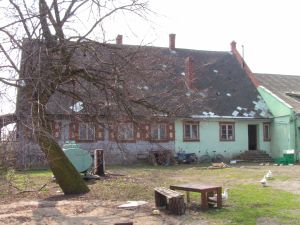 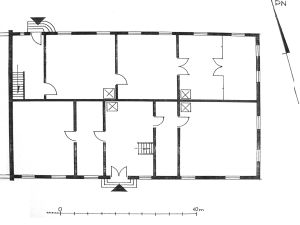 No. 47 - house built in the third quarter of the 19th century, with its gable facing a road running through the village in the direction of Zaj±czkowo; located in the north eastern part of the village, housing the farm and residential section lined-up under one roof.
No. 47 - house built in the third quarter of the 19th century, with its gable facing a road running through the village in the direction of Zaj±czkowo; located in the north eastern part of the village, housing the farm and residential section lined-up under one roof.
The building is on the plan of a rectangle, double-bay with a hallway in the southern bay. At present divided into two separate appartments. Entrance doors in the northern and southern elevations. Single-floor with mansard roofs in the roof surface, has a cellar under part of it. Covered with a double-pitched roof. The loft has a residential and usable character. The northern and southern elevations are seven-axial, unsymmetrical. The eastern elevation is four-axial, unsymmetrical with a porch covered with a double-pitched roof. The western elevation is connected with farm section.
The house rests on a brick and stone plinth, is made of wood and has a corner-notched structure. Brick western wall. Brick, simple chimney. Wooden floors, beam ceiling with bevelled edges. The gables are planked. Collar beam roof truss with king posts. Roof covered with ceramic tiles. Wooden, double-cased windows in window-frames. Wooden, single- and double-leaf doors having a frame and panel structure. Simple wooden straight-flight staircase.
Documents on which the study was based: Wielki Lubień 47, Historic Monuments of Architecture and Construction Registry Card, elaborated by I. Jastrzębska-Puzowska, E. Sekuła-Tauer, K. Bartowski, typescript, Bydgoszcz 1993; Osadnictwo holenderskie Doliny Wisły w województwie bydgoskim, typescript, Bydgoszcz 1992/1993, part 1, p. 9; Osadnictwo holenderskie Doliny Wisły w województwie bydgoskim, typescript, Bydgoszcz 1992/1993, part 3, No. 22; Zabytki architektury i budownictwa w Polsce. Województwo Bydgoskie, elaborated by K. Parucka vol. 5, Warszawa 1997, part 2, p. 85.
 No. 48 - house built c.a. mid-19th century, with its gable facing road running through the village; located in its north-eastern part, housing the farm and residential section lined-up under one roof.
No. 48 - house built c.a. mid-19th century, with its gable facing road running through the village; located in its north-eastern part, housing the farm and residential section lined-up under one roof.
The building is on the plan of a rectangle, double-bay with a hallway in the southern bay. Kitchen in the northern part. In the middle axis a \'black kitchen\' preserved. Entrance doors in the western and southern elevations. Single-floor, with a cellar under part of it. Covered with a double-pitched roof. The loft is usable. The northern elevation is five-axial, unsymmetrical. The southern elevation is six-axial, unsymmetrical. The eastern elevation is connected with the farm section. The western elevation is single-axial, unsymmetrical.
The house rests on a brick and stone plinth, is made of wood and has a corner-notched structure. The farm section is made of brick. Brick, bottle-shaped chimney. Wooden floors, Beam ceilings, panels between them ceiled with board. The gables are planked. Collar beam roof truss. The roof is covered with asbestos cement. Wooden, double-cased windows in window-frames. Wooden, single- and double-leaf doors having a frame and panel structure. Simple, wooden straight-flight staircase.
Documents on which the study was based: Osadnictwo holenderskie Doliny Wisły w województwie bydgoskim, typescript, Bydgoszcz 1992/1993, part 1, p. 9.
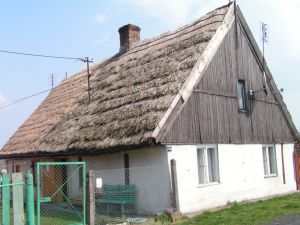 No. 74 - house built c.a. mid-19th century, with its gable facing a road perpendicular to the embankment; located in the north-eastern part of the village, not connected with farm buildings. The homestead has a dispersed layout.
No. 74 - house built c.a. mid-19th century, with its gable facing a road perpendicular to the embankment; located in the north-eastern part of the village, not connected with farm buildings. The homestead has a dispersed layout.
The building is on the plan of a rectangle, double-bay with a hallway in the western bay. \'Black kitchen\' preserved. Entrance door in the western elevation. Single-floor, with a cellar under part of it. Covered with a double-pitched roof. The loft is usable. The northern elevation is single-axial, symmetrical. The southern elevation is bi-axial, symmetrical. The eastern elevation is bi-axial, unsymmetrical. The western elevation is tri-axial, unsymmetrical.
The house rests on a brick and stone plinth, is made of wood and has a corner-notched structure. Plastered. Brick, bottle-shaped chimney. Wooden floors, beam ceilings. The gables are planked. Collar beam roof truss. The roof is thatched. Wooden, double-cased box windows. Wooden, single-leaf, frame and panel doors. Simple, wooden straight-flight staircase.
Documents on which the study was based: Osadnictwo holenderskie Doliny Wisły w województwie bydgoskim, typescript, Bydgoszcz 1992/1993, part 1, p. 9.
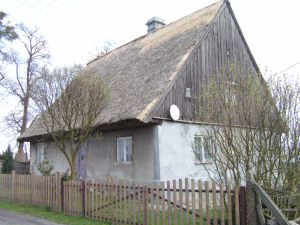 No. 78 - house built in the second quarter of the 19th century, with its gable facing a road running parallel to the embankment; located in the north-eastern part of the village, not connected with farm buildings. The homestead has a dispersed layout. Near the house a cemetery is located. The cottage could have been used as a school.
No. 78 - house built in the second quarter of the 19th century, with its gable facing a road running parallel to the embankment; located in the north-eastern part of the village, not connected with farm buildings. The homestead has a dispersed layout. Near the house a cemetery is located. The cottage could have been used as a school.
The building is inacessible. Single-floor, covered with a double-pitched roof. The northern and eastern elevations are single-axial, unsymmetrical. The eastern elevation is inaccessible. The western elevation is tri-axial, unsymmetrical. Entrance door in the western elevation.
The house rests on a brick and stone plinth, is made of wood and has a corner-notched structure. Plastered. The gables are planked. The roof is covered with asbestos cement. Wooden, double-cased windows in window-frames. Wooden, single-leaf, frame and panel doors.
SGKP, t. 5, Warszawa 1893, s. 409-410; H. Maercker, Eine polnische Starostei und ein preussischer Landrathkreis. Geschichte des Schwetzer Kreises 1466-1873, "Zeitschrift des Westpreussischen Geschichtvereins", H. 17-19, Danzig 1886-1888, s. 251-253; Visitationes Archidiaconatus Pomeraniae 1583, wyd. S. Kujot, TNT, Fontes 1, Toruń 1897, s. 78; Opis królewszczyzn w województwach chełmińskim, pomorskim i malborskim w roku 1664, wyd. J. Paczkowski, TNT, Fontes 32, Toruń 1938, s. 80; Biskup M., Tomczak A., Mapy województwa pomorskiego w drugiej połowie XVI w., Rocznik TNT, R. 58, 1955, z. 1, s. 127; Inwentarz starostwa grudzi±dzkiego z roku 1739, Grudzi±dz 1963, s. 50; Lustracja województw Prus Królewskich 1624 z fragmentami lustracji 1615, wyd. S. Hoszkowski, Gdańsk 1967, s. 45, 264; K. Ciesielska,, Osadnictwo "olęderskie" w Prusach Królewskich na Kujawach w ¶wietle kontraktów osadniczych, "Studia i Materiały z dziejów Wielkopolski i Pomorza", t. 4, 1958, s. 222; Katalog zabytków architektury i budownictwa w Polsce, z. 2, M. Arszyński, M. Rejmanowski, Województwo bydgoskie,(Biblioteka Muzealnictwa i Ochrony Zabytków, Seria A, t. VII, Warszawa 1972, s. 63; Zabytki architektury województwa bydgoskiego, red. M. E. G±siorowscy, Bydgoszcz 1974, s. 225; Katalog zabytków sztuki w Polsce, T.XI, Dawne województwo bydgoskie, red. T. Chrzanowski, M. Kornecki, z. 15: Powiat ¶wiecki, oprac. T. Chrzanowski i T. Żurkowska, Warszawa 1977, s. 12-13; K. Mikulski, Osadnictwo wiejskie woj. Pomorskiego od poł XVI do końca XVII wieku, Rocznik TNT, R. 86, Toruń 1994, z. 2, s. 165; Katalog zabytków województwa bydgoskiego, oprac. K. Parucka, E. Raczyńska-M±kowska, Bydgoszcz 1997, s. 56; P. J. Klassen, Ojczyzna dla przybyszów, Wprowadzenie do historii mennonitów w Polsce i Prusach, Warszawa 2002, s. 42; Atlas zabytków architektury, opr. H. Faryna-Paszkiewicz, M. Omilanowska, R. Pasieczny, Warszawa 2001, s. 150.SGKP, t. 5, Warszawa 1893, s. 409-410; H. Maercker, Eine polnische Starostei und ein preussischer Landrathkreis. Geschichte des Schwetzer Kreises 1466-1873, "Zeitschrift des Westpreussischen Geschichtvereins", H. 17-19, Danzig 1886-1888, s. 251-253; Visitationes Archidiaconatus Pomeraniae 1583, wyd. S. Kujot, TNT, Fontes 1, Toruń 1897, s. 78; Opis królewszczyzn w województwach chełmińskim, pomorskim i malborskim w roku 1664, wyd. J. Paczkowski, TNT, Fontes 32, Toruń 1938, s. 80; Biskup M., Tomczak A., Mapy województwa pomorskiego w drugiej połowie XVI w., Rocznik TNT, R. 58, 1955, z. 1, s. 127; Inwentarz starostwa grudzi±dzkiego z roku 1739, Grudzi±dz 1963, s. 50; Lustracja województw Prus Królewskich 1624 z fragmentami lustracji 1615, wyd. S. Hoszkowski, Gdańsk 1967, s. 45, 264; K. Ciesielska,, Osadnictwo "olęderskie" w Prusach Królewskich na Kujawach w ¶wietle kontraktów osadniczych, "Studia i Materiały z dziejów Wielkopolski i Pomorza", t. 4, 1958, s. 222; Katalog zabytków architektury i budownictwa w Polsce, z. 2, M. Arszyński, M. Rejmanowski, Województwo bydgoskie,(Biblioteka Muzealnictwa i Ochrony Zabytków, Seria A, t. VII, Warszawa 1972, s. 63; Zabytki architektury województwa bydgoskiego, red. M. E. G±siorowscy, Bydgoszcz 1974, s. 225; Katalog zabytków sztuki w Polsce, T.XI, Dawne województwo bydgoskie, red. T. Chrzanowski, M. Kornecki, z. 15: Powiat ¶wiecki, oprac. T. Chrzanowski i T. Żurkowska, Warszawa 1977, s. 12-13; K. Mikulski, Osadnictwo wiejskie woj. Pomorskiego od poł XVI do końca XVII wieku, Rocznik TNT, R. 86, Toruń 1994, z. 2, s. 165; Katalog zabytków województwa bydgoskiego, oprac. K. Parucka, E. Raczyńska-M±kowska, Bydgoszcz 1997, s. 56; P. J. Klassen, Ojczyzna dla przybyszów, Wprowadzenie do historii mennonitów w Polsce i Prusach, Warszawa 2002, s. 42; Atlas zabytków architektury, opr. H. Faryna-Paszkiewicz, M. Omilanowska, R. Pasieczny, Warszawa 2001, s. 150.
|


 No. 45 - house built in 1833, with its ridge facing a road leading to the embankment; located in the north-eastern part of the village, not connected with farm buildings. The homestead has a dispersed layout. Originally in the lintel there was an inscription "Johann Dobrau B. D Jacob Rathler B. M. 1833".
No. 45 - house built in 1833, with its ridge facing a road leading to the embankment; located in the north-eastern part of the village, not connected with farm buildings. The homestead has a dispersed layout. Originally in the lintel there was an inscription "Johann Dobrau B. D Jacob Rathler B. M. 1833".
 No. 47 - house built in the third quarter of the 19th century, with its gable facing a road running through the village in the direction of Zaj±czkowo; located in the north eastern part of the village, housing the farm and residential section lined-up under one roof.
No. 47 - house built in the third quarter of the 19th century, with its gable facing a road running through the village in the direction of Zaj±czkowo; located in the north eastern part of the village, housing the farm and residential section lined-up under one roof. No. 48 - house built c.a. mid-19th century, with its gable facing road running through the village; located in its north-eastern part, housing the farm and residential section lined-up under one roof.
No. 48 - house built c.a. mid-19th century, with its gable facing road running through the village; located in its north-eastern part, housing the farm and residential section lined-up under one roof.  No. 74 - house built c.a. mid-19th century, with its gable facing a road perpendicular to the embankment; located in the north-eastern part of the village, not connected with farm buildings. The homestead has a dispersed layout.
No. 74 - house built c.a. mid-19th century, with its gable facing a road perpendicular to the embankment; located in the north-eastern part of the village, not connected with farm buildings. The homestead has a dispersed layout. No. 78 - house built in the second quarter of the 19th century, with its gable facing a road running parallel to the embankment; located in the north-eastern part of the village, not connected with farm buildings. The homestead has a dispersed layout. Near the house a cemetery is located. The cottage could have been used as a school.
No. 78 - house built in the second quarter of the 19th century, with its gable facing a road running parallel to the embankment; located in the north-eastern part of the village, not connected with farm buildings. The homestead has a dispersed layout. Near the house a cemetery is located. The cottage could have been used as a school.